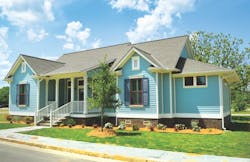Ample Infill for Thin Lots
While infill projects continue to provide opportunities for builders in many areas, some of the locations might be surprising. As you would expect, most are found in large cities where there?s a walkable and vibrant area with close proximity to entertainment and work; however, opportunities are also appearing in smaller towns where there?s a growing interest in older and, often, historic neighborhoods. Although perhaps lacking the vibrancy of a larger urban setting, many of the smaller downtowns offer pedestrian-friendly environments and economical building sites.
They become particularly appealing to the growing number of retirees looking for a slower pace of life and who have no concern about being close to their workplace. The desire for smaller, single-family homes located in small-scale neighborhoods is addressed with the following infill concepts from our design team. These include unique solutions for garage placement, viable alternatives to multi-story condos on a waterfront site, and practical designs that thoughtfully blend in with existing older homes.
For past House Review topics, click here.
[PAGEBREAK]
Byers Avenue
[PAGEBREAK]
Clover Meadow
[PAGEBREAK]
Sunset Inlet
[PAGEBREAK]
The McKinley
[PAGEBREAK]














